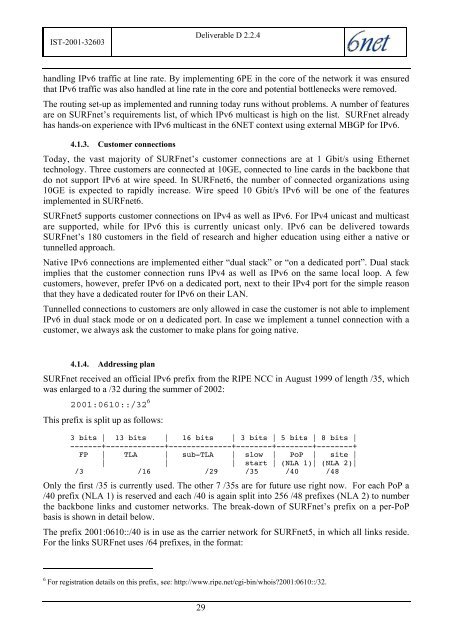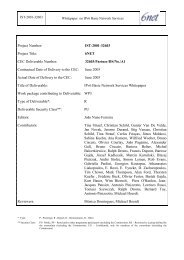D2.2.4: Final IPv4 to IPv6 Transition Cookbook for ... - 6NET
D2.2.4: Final IPv4 to IPv6 Transition Cookbook for ... - 6NET
D2.2.4: Final IPv4 to IPv6 Transition Cookbook for ... - 6NET
Create successful ePaper yourself
Turn your PDF publications into a flip-book with our unique Google optimized e-Paper software.
IST-2001-32603Deliverable D 2.2.4handling <strong>IPv6</strong> traffic at line rate. By implementing 6PE in the core of the network it was ensuredthat <strong>IPv6</strong> traffic was also handled at line rate in the core and potential bottlenecks were removed.The routing set-up as implemented and running <strong>to</strong>day runs without problems. A number of featuresare on SURFnet’s requirements list, of which <strong>IPv6</strong> multicast is high on the list. SURFnet alreadyhas hands-on experience with <strong>IPv6</strong> multicast in the <strong>6NET</strong> context using external MBGP <strong>for</strong> <strong>IPv6</strong>.4.1.3. Cus<strong>to</strong>mer connectionsToday, the vast majority of SURFnet’s cus<strong>to</strong>mer connections are at 1 Gbit/s using Ethernettechnology. Three cus<strong>to</strong>mers are connected at 10GE, connected <strong>to</strong> line cards in the backbone thatdo not support <strong>IPv6</strong> at wire speed. In SURFnet6, the number of connected organizations using10GE is expected <strong>to</strong> rapidly increase. Wire speed 10 Gbit/s <strong>IPv6</strong> will be one of the featuresimplemented in SURFnet6.SURFnet5 supports cus<strong>to</strong>mer connections on <strong>IPv4</strong> as well as <strong>IPv6</strong>. For <strong>IPv4</strong> unicast and multicastare supported, while <strong>for</strong> <strong>IPv6</strong> this is currently unicast only. <strong>IPv6</strong> can be delivered <strong>to</strong>wardsSURFnet’s 180 cus<strong>to</strong>mers in the field of research and higher education using either a native ortunnelled approach.Native <strong>IPv6</strong> connections are implemented either “dual stack” or “on a dedicated port”. Dual stackimplies that the cus<strong>to</strong>mer connection runs <strong>IPv4</strong> as well as <strong>IPv6</strong> on the same local loop. A fewcus<strong>to</strong>mers, however, prefer <strong>IPv6</strong> on a dedicated port, next <strong>to</strong> their <strong>IPv4</strong> port <strong>for</strong> the simple reasonthat they have a dedicated router <strong>for</strong> <strong>IPv6</strong> on their LAN.Tunnelled connections <strong>to</strong> cus<strong>to</strong>mers are only allowed in case the cus<strong>to</strong>mer is not able <strong>to</strong> implement<strong>IPv6</strong> in dual stack mode or on a dedicated port. In case we implement a tunnel connection with acus<strong>to</strong>mer, we always ask the cus<strong>to</strong>mer <strong>to</strong> make plans <strong>for</strong> going native.4.1.4. Addressing planSURFnet received an official <strong>IPv6</strong> prefix from the RIPE NCC in August 1999 of length /35, whichwas enlarged <strong>to</strong> a /32 during the summer of 2002:2001:0610::/32 6This prefix is split up as follows:3 bits | 13 bits | 16 bits | 3 bits | 5 bits | 8 bits |-------+-------------+--------------+--------+--------+--------+FP | TLA | sub-TLA | slow | PoP | site || | | start | (NLA 1)| (NLA 2)|/3 /16 /29 /35 /40 /48Only the first /35 is currently used. The other 7 /35s are <strong>for</strong> future use right now. For each PoP a/40 prefix (NLA 1) is reserved and each /40 is again split in<strong>to</strong> 256 /48 prefixes (NLA 2) <strong>to</strong> numberthe backbone links and cus<strong>to</strong>mer networks. The break-down of SURFnet’s prefix on a per-PoPbasis is shown in detail below.The prefix 2001:0610::/40 is in use as the carrier network <strong>for</strong> SURFnet5, in which all links reside.For the links SURFnet uses /64 prefixes, in the <strong>for</strong>mat:6 For registration details on this prefix, see: http://www.ripe.net/cgi-bin/whois?2001:0610::/32.29






